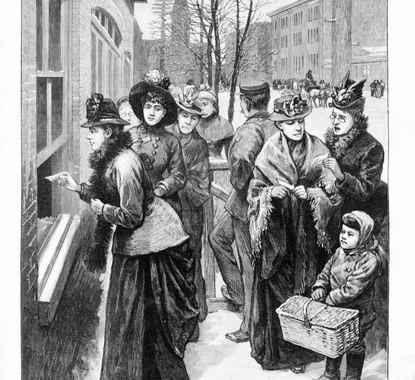Wyoming: The First State To Grant Voting Rights To Women
Photo Credit: Everett Historical
LISTEN ON SOUNDCLOUD:
Admitted to Union July 10, 1890, Wyoming became the forty-fourth state to ratify the U.S. Constitution. Known as “The Equality State,” it currently uses the Wyoming State Constitution adopted in 1889. While amended many times, it is the only state constitution Wyoming has had in its history, last amended in 2008.
Becoming a State
In 1869, the Wyoming Territory organized after Congress passed an act creating the territory in July 1868, with the territory seeking statehood from the beginning. Despite statehood being more than thirty years in the territory’s future, Wyoming’s first territorial governor, John A. Campbell, signed the “Female Suffrage” in 1869 and Wyoming became the first territory, then when admitted as a state, to grant voting rights to women.
In addition to that act, Wyoming has been a leader in equal rights from its organization as a territory. Women served on juries beginning in 1870, the first female court bailiff was in Wyoming in 1870, and the first female governor in the nation, Nellie Tayloe Ross, was sworn into office in January 1925.
In 1888, the Territorial Assembly petitioned Congress for statehood, but that effort was not successful. Despite not being approved for statehood in 1888, Wyoming Territory Governor Francis E. Warren and other territorial leadership decided to hold an election for delegates to a constitutional convention. On September 30, 1889, the Constitutional Convention was held and a state constitution was drafted that was submitted to voters. A short time later, on November 5,1889, the constitution was approved by an overwhelming majority of Wyoming voters, 6,272 to 1,923.
With a new constitution, the Wyoming Territory pushed for statehood again, and after President Benjamin Harrison signed Wyoming’s statehood bill, Wyoming became the 44th state on July 10,1890.
The Wyoming Constitution
The state has been known as “The Equality State” from its early days, with the Suffrage Act passed and also the state constitution, which provides at Article 1, Declaration of Rights, Sections 2 and 3 the strong belief in equality, stating:
Sec. 2. Equality of all. In their inherent right to life, liberty and the pursuit of happiness, all members of the human race are equal.
Sec. 3. Equal political rights. Since equality in the enjoyment of natural and civil rights is only made sure through political equality, the laws of this state affecting the political rights and privileges of its citizens shall be without distinction of race, color, sex, or any circumstance or condition whatsoever other than individual incompetency, or unworthiness duly ascertained by a court of competent jurisdiction.
Forty-six delegates assembled in Cheyenne, Wyoming, in September 1889, and on September 30, 1889, the delegates signed the constitution. Although amended on numerous occasions (the changes can be seen in the document at https://soswy.state.wy.us/Forms/Publications/09WYConstitution.pdf), the bulk of the Wyoming Constitution has remained unchanged since its origins almost 130 years ago.
The Wyoming Constitution has other rights that are consistent with the United States Constitution Bill of Rights, and its right to bear arms provision makes it clear it is a right to defend oneself and the state, providing:
Sec. 24. Right to bear arms. The right of citizens to bear arms in defense of themselves and of the state shall not be denied.
In addition to the extensive Declaration of Rights, the Wyoming Constitution is very detailed in terms of limitations on the state’s public indebtedness.
Conclusion
Wyoming became the 44th state to join the United States, but in equal rights, stands out as the first, earning its nickname as “The Equality State.” Wyoming is also known as the “Cowboy State” in homage to its use of the bucking bronco as its symbol.
Dan Cotter is a partner at Latimer LeVay Fyock LLC and an adjunct professor at The John Marshall Law School, where he teaches SCOTUS Judicial Biographies. His book, “The Chief Justices,” (April 2019, Twelve Tables Press), is available now. He is also a past president of The Chicago Bar Association. The article contains his opinions and is not to be attributed to anyone else.
Click Here for the next essay.
Click Here for the previous essay.
Click Here to have the NEWEST essay in this study emailed to your inbox every day!
Click Here to view the schedule of topics in our 90 Day Study on Congress.




Join the discussion! Post your comments below.
Your feedback and insights are welcome.Feel free to contribute!